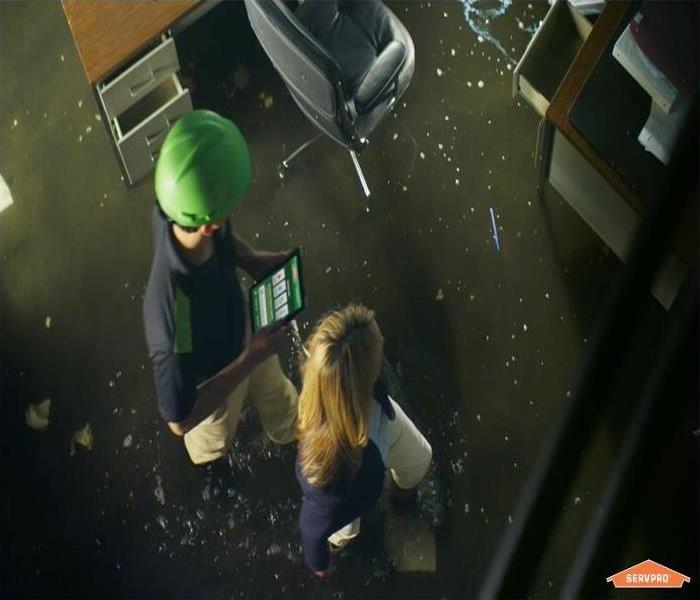Basic Steps to Commercial Mold Restoration in Cartersville GA
5/25/2018 (Permalink)
 Finding mold in in your commercial building doesn't have to ruin your business. Call SERVPRO of Bartow County (770) 387-7455
Finding mold in in your commercial building doesn't have to ruin your business. Call SERVPRO of Bartow County (770) 387-7455
Do you run a business in Bartow County? Do you have a mold problem that you want to be remedied immediately but don’t have the slightest clue about what happens during remediation?
Like any other business owner or manager, you need accurate and reliable information to make important business decisions. If the answer to the above questions is yes, you should keep reading on below to learn what commercial mold restoration typically involves.
Why is Mold Remediation Necessary?
Mold growth can occur anywhere, be it indoors or outdoors. However, it thrives in areas with wet and humid environments.
For the most part, this fungus that grows outdoors does not present any significant problems for people and businesses. But when the growth occurs indoors, it becomes a major source of worry to building owners and the people that occupy the affected buildings.
Mold remediation is meant to restore normal levels inside a building.
What Happens During Commercial Remediation?
No two restoration situations are exactly the same, but the basics of mold remediation remain unchanged in all situations.
The basic steps to commercial remediation include the following:
1. Getting in Touch with Remediation Specialists
The process begins when you call the professionals working at a mold remediation company/service and inform them that you have a mold problem in your commercial building. They will arrive at your business location in the shortest time possible, prompt response to the problem is critical.
Every business owner or manager needs to keep the emergency contact of a trusted remediation service with them all the time so they can immediately call for help when a problem arises.
2. Inspection and Testing
Upon arriving at your commercial premises, the remediation experts will carry out a thorough inspection of your building to identify areas that have been affected by mold damage.
The inspection involves identifying obvious signs of mold growth, like the presence of colored, fluffy growths on the walls, ceilings, floors and other surfaces of the building interiors. This is known as a visual mold assessment.
The inspection also involves performing a series of tests to see if spores are airborne, growing on various surfaces of the building interiors without showing any visible signs, or in settled dust.
There are many different techniques that can be used to detect infestation. Your mold remediation specialist will select the most appropriate testing methods for your specific situation.
3. Containment
Once the trouble areas have been identified and severity of damage ascertained, measures will be taken to contain the mold. The containment is meant to maximize protection and limit further damage to your property.
Mold produces spores, which can quickly spread into the air and contaminate it. In addition, it requires oxygen and moisture to thrive, so cutting off oxygen and moisture supply to infested areas is a critical part of containment.
4. Air Sanitization
This involves using an air purifier equipped with an air filter to remove spores that may linger in the air.
When exposed to a water or moisture source, the spores can quickly turn into colonies and cause a recurrence of mold problems.
There are many types of air filters that may be used in tandem with air purifiers, but HEPA filters are generally considered to be the most effective at the job.
5. Removal
Once spores have been completely removed from the air, the mold and the affected materials in your building will be the next to be removed.
This is a job that requires specialized handling and advanced equipment because mold growth can easily become airborne and settle on other surfaces if it not properly removed.
The process for removal varies from scenario to scenario, depending on the extent of infestation in your building.
Before getting started with mold removal, the water or moisture source causing the problem will need to be identified and remedied. Otherwise, mold growth and damage will continue even after it has been removed.
6. Cleanup
Cleanup involves cleaning various items and surfaces, such as wood furniture, walls, and floors that may be contaminated by mold.
The principal goal is to eliminate the growth that may still be lingering in your commercial space even after removal.
It is, however, important to point out that not all items in your commercial space may be restorable through cleaning service.
Absorbent belongings like carpets and upholstery furniture, for example, may need to be replaced.
We Are Here to Help
At SERVPRO of Bartow County, we pride in helping both residential and commercial clients remedy mold damage in their indoor spaces. Don’t hesitate to reach if you need help with your remediation project






 24/7 Emergency Service
24/7 Emergency Service